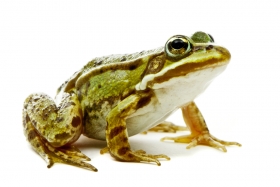Amphibians Evolve Resistance To Popular Pesticide

Rachel Carson and, more recently, Sandra Steingraber have successfully drawn popular attention to the risks of pesticides on wildlife. Many of the environmental consequences of pesticides have now been well documented by scientists; however, studies investigating the evolutionary consequences of pesticides on non-target species are largely missing. Not surprisingly, most studies looking at how species evolve in response to pesticide-use have been on target species such as mosquitoes and crop pests, which show that some target species have evolved resistance to common pesticides. But, in a new study in Evolutionary Applications, Rickey Cothran and his colleagues at the University of Pittsburgh are the first to show evidence that non-target species, in this case frogs, may also evolve resistance to two popular pesticides.
In this study, wood frogs' (Lithobates sylvaticus) tadpoles were exposed to two chemical pesticides, Chlopyrifos and Roundup, in order to determine variation in resistance. Egg masses were collected from ponds near agricultural fields. These were hatched in laboratory conditions and then exposed to the two pesticides for 48 hours in order to assess each population's level of tolerance to the pesticides. The researchers found that wood frogs closer to agricultural fields had higher survival rates when exposed to Chlopyrifos than populations further from agricultural fields. This indicates that some wood frog populations have developed resistance to this pesticide. Amazingly, these wood frogs may be the first vertebrate species to show such resistance. Chlorpyrifos, is an organophosphate pesticide that was introduced by DOW chemical company in 1965. The pesticide kills insects such as aphids, mites, and various worms that destroy food and feed crops. It is the most commonly used pesticide in the United States with over 10 million pounds applied annually, however Chlorpyrifos has been shown to be highly toxic to many non-target animals, including amphibians, fish, and bees.
Despite the surprising findings on Chlopyrifos, the researchers found no evidence that wood frog populations have gained resistance to the herbicide Roundup. The most common herbicide in the U.S., Roundup (Glyphosate), is a broad-spectrum pesticide used to suppress and kill weeds. In 2007, the U.S. agriculture sector used more than 180 million pounds of Roundup; more than 5 million pounds was used by residential home and garden users, and industry, commerce, and the government used more than 13 million pounds.
When asked why the wood frog evolved resistance to Chlopyrifos but not Round-up, Cothran told mongabay.com, "It could be that the herbicide is more broadly applied (e.g., outside of the agricultural sector) so that populations that were not near agriculture may have been exposed."
Continue Reading at Mongabay.com
Frog via Shutterstock
2013©. Copyright Environmental News Network